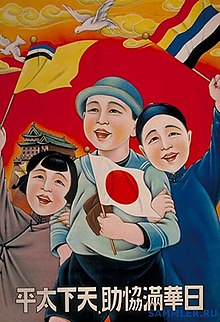

The flag of the Empire of Manchuria had a yellow field with four horizontal stripes of different colors in the upper left corner. The colors of the flag were based on the colors on the Five Races Under One Union flags used by the Beiyang government, the Empire of China, and by the Fengtian clique. The flag was first established in Announcement of National Flag on March 1, 1932.[1] In 2020, display of the flag was banned in Hong Kong under the national security law, together with eight other "independence flags."[a][3]
Description
According to the Document of the Explanation of National Flag issued by the State Council of Manchukuo on February 24, 1933, the colors on the flag represent the four directions and center.[4] The Study of Manchukuo National Flag published by state council of Manchukuo later also gave a representative based on Five Elements.[5]
- Yellow represents the center and the Manchus; rule of emperor of four directions and virtue of Ren in Confucianism, and earth in the Five Elements.
- Red represents the south and the Han, passion and courage, and fire in the Five Elements.
- Blue represents the east and the Mongols, youthfulness and holiness, and wood in the Five Elements.
- White represents the west and the Japanese, purity and justice, and gold in the Five Elements.
- Black represents the north and the Koreans, will and determination, and water in the Five Elements.[6][7]
Manchukuo naval rank flags were similar in design to those of the Soviet Navy but retained the national colors.
Other flags
Manchukuo Imperial Navy
1932–1935
-
Flag of an admiral
-
Flag of a vice admiral
-
Flag of a rear admiral
-
Flag of a 1st class commodore
1935–1941
-
Flag of the Navy Minister
-
Flag of an admiral
-
Flag of a vice admiral
-
Flag of a rear admiral
-
Flag of a 1st class commodore
-
Flag of a commander (2nd class commodore)
-
Flag of a superior commander
Coast Guard
-
Flag of the Manchukuo Shipping Office
-
Flag of marine support ships
-
Flag of the Manchukuo Coast Guard
Marine Police
-
Flag of the Marine Police
-
Flag of the Chief of Civil Administration
-
Flag of the Chief of Police Civil Administration
-
Flag of the Chief of Marine Police
-
Flag of the Marine Police Senior Officer at Present Afloat
Postal flag
-
Postal flag of Manchukuo
Political organizations
-
Flag of the Concordia Association
Boy Scouts of Manchukuo
-
Flag of the Boy Scouts of Manchukuo
South Manchuria Railway Company
-
Flag of the South Manchuria Railway Company
See also
Notes
- ^ The other eight flags are the flag of the Shanghai National Party, the flag of the Inner Mongolian People's Party, the flag of Tibet, the flag of East Turkestan, the flag of the World Taiwanese Congress, the Basharan independence flag, the Kapok flag, and the Fujian-Vietnam Independence Flag.[2]
References
- ^ "満洲國政府公報日譯" 第1号、1932年4月1日、3頁
- ^ "九獨旗". Justice News 公正新聞 (in Cantonese). January 3, 2019. Retrieved April 7, 2024.
- ^ "【立法護國安】展示「光時」旗 涉違國安法 - 香港文匯報". Wen Wei Po. July 2, 2020. Retrieved April 7, 2024.
- ^ 对国旗意义的解释文件, State council of Manchukuo, 24 February 1933
- ^ 《新国家大満洲》,趙欣伯 著,東京書房,昭和7年
- ^ 貴志俊彦著『満洲国のビジュアル・メディア―ポスター・絵はがき・切手』、吉川弘文館 22頁、ISBN 978-4642080361
- ^ 《新国家大満洲》,趙欣伯 著,東京書房,昭和7年































You must be logged in to post a comment.